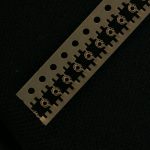 Although a few processes use heated material, metal stamping typically takes cold metal and puts it in-between dies. By pressing the material, you can form the desired shape from the metal. These shapes usually create components or tools for bigger formations. Sometimes, “pressing” is a term used to refer to metal stamping by some individuals in the fabrication industry.
Although a few processes use heated material, metal stamping typically takes cold metal and puts it in-between dies. By pressing the material, you can form the desired shape from the metal. These shapes usually create components or tools for bigger formations. Sometimes, “pressing” is a term used to refer to metal stamping by some individuals in the fabrication industry.
In the machines, the stamping dies either form or cut the metal. Usually, the dies have certain designs for every single project. Although it may take a while to make dies, the stamping process takes place very fast once finished with the die. For this reason, the process enables the production of large quantities of identical parts.
Coining, bending, flanging, embossing, blanking, and punching are some of the stamping process’ stages a metal might undergo. Due to its exceptional feature in versatility, stamping has become an excellent production method for various industries such as manufacturing, public transportation, military, automotive sectors, etc.
Different Types of Metal Stamping
– Precision Metal Stamping
With this type, it involves the creation of raised images or 3D results and pieces in finished products that have tight tolerances. Precision stamping, as opposed to other forms of stamping, involves fewer material movements between the machines, which fastens the process.
– Hot Metal Stamping
The process involves the formation of metal using extreme heat. Boron steel, the metal is heated in high temperatures and quenched in the die itself to form a strong, lightweight steel part.
– Progressive Die/Metal Stamping
It involves taking metal pieces via many stations that each carry out a separate task on the metal. During these different phases, the metal piece is still affixed to a long strip of material. The metal strip’s finished piece is cut by the last machine. When choosing fabrication techniques for long-run processes that need large quantities, progressive die stamping is an ideal choice. What’s more, the process generates minimal waste, and the dies last a long time.
Different Types of Metal Stamping Materials Used by Fabricators
For stamping, fabricators often begin with a piece of thinly crafted sheet metal. Generally, the metal provides strength for the specific finished products while maintaining enough flexibility for the stamping process.
The choice of the type of metal to use will determine the force required to shape and cut it. Understanding the types of press forces, as well as processes to apply with which materials are part of the metal stamping’s expert knowledge. Some of the most popular categories of metals used include:
– Ferrous Metals. Stainless steel and other iron-based metals. They often have lower production prices and cost the least.
– Non-Ferrous Metals. Brass, bronze, nickel, and other metals that do not consist of iron.
– Non-Standard Alloys. In these alloys, the metals rely on the desired features of the final product.
– Precious Metals. Although gold, silver, and platinum tend to be costly, they’re required for certain applications.
What Happens During the Formation Stage?
Forming takes place when a press bends; if not, it shapes the metal. A few methods shape the metal, based on the thickness of the metal, as well as how the final part looks like.
– Bending. It involves the folding of the metal along one, straight axis.
– Coining. It’s the pressing of the metal into a finished part that has crisp edges.
– Drawing. It pulls a metal over a form allowing the material to stretch. Examples of drawing products include metals sinks and oil pans.
– Embossing. A machine usually stretches and pulls a metal onto a depression whenever it requires a design on it. Images, designs, and lettering need embossing for their formation on metal surfaces
– Flanging. Flanging, quite similar to bending, is the folding of the metal along an axis that curves rather than the straight line created through bending
– Hemming. It forms an extra-strong edge where the bottom is folded up onto itself.
Cutting Processes
Generally, the cutting of the metal might take place before or after the formation, based on the type of stamping process used. Progressive die stamping, for instance, trims the final product once the process comes to an end. Transfer die stamping, however, begins by cutting off the metal. The choice of cutting methods need a variety of cutting dies to obtain the desired result. These include blanking, lancing, punching, shearing, and trimming.
To those who choose it for part creation, the stamping process provides numerous benefits. Metalworkers can create large quantities of parts in relatively little time after producing the dies. What’s more, metal stamping’s die production has a significantly lower price tag compared to other types of metal forming.





